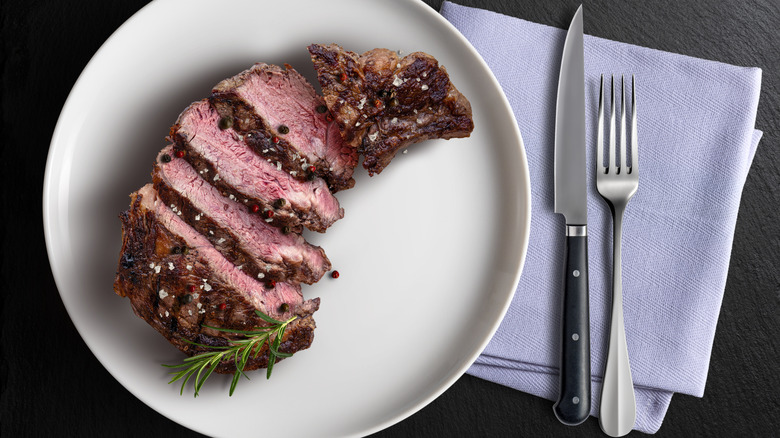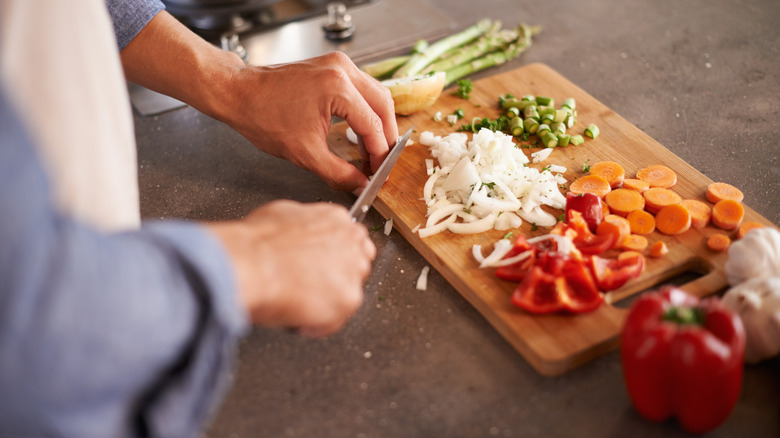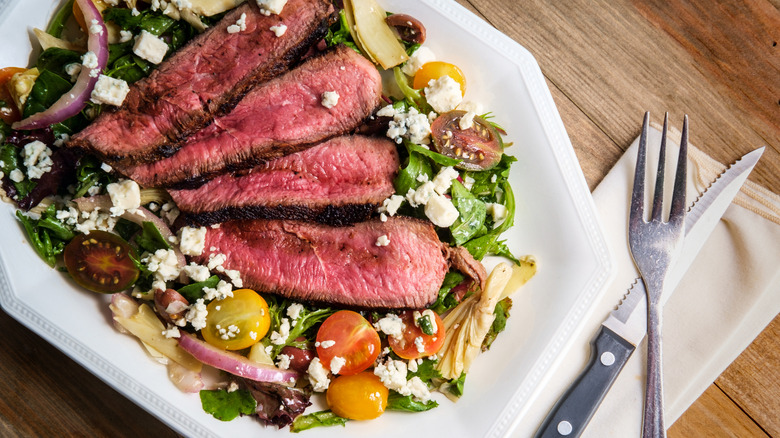Trying To Eat Less Meat? Make It The Side, Not The Star
If you're looking to reduce your meat intake, an excellent way to do it is readjusting meat's status on your household table. Move the beef, pork, poultry, and seafood from starring role to side dish status. Since main dishes are typically the heartiest component of a meal, it's generally expected that filling, protein-rich meat will feature prominently in that prime spot (unless, of course, you're dining in a vegan or vegetarian household). It doesn't help that people in the United States eat more meat than almost any other country in the world.
Historically, one of the amazing features of the Land of the Free was how abundantly meat was available, no matter one's social or financial status. That outlook helped shape the prevailing view that eating meat is the American way. In other words, we're just accustomed to consuming a lot of it. One way to swim against this carnivorous current is reapproaching the dishes you already make on a regular basis, reducing the amount of meat in them while upping the ante with other ingredients. A little creative analysis and planning are all it takes, and shifting the amount of meat you serve — highlighting other dishes and ingredients in its place — is easier than you may think. Just think of meat as a side instead of the star of the show.
Revamping your go-to recipes to reduce the meat
The dishes you already make on the regular can be easily revamped to feature less meat. If your household likes weekly meatloaf night, for instance — not surprising since meatloaf is America's favorite dinner — it's super easy to reduce the amount of beef in the dish. Meatloaf already includes fillers and binders, so simply increase the nonmeat ingredients. Veggies like grated raw potato and finely chopped carrots and zucchini incorporate seamlessly into a meatloaf mixture, simultaneously reducing the meat content and increasing veggie intake. This same approach can be applied to meatballs, like slow cooker Italian turkey and zucchini meatballs, and burgers. Your family will likely never notice they're consuming less than usual! In fact, you can skip the meat entirely and make meatless meatballs with ricotta cheese.
Have a fun kebab night, stacking extra veggies in between the meat pieces. You can fill out the meal with the best side dishes to pair with kebabs, and nonmeat protein can be brought into the mix with an element like Argentinian provoleta. This is a thickly sliced provolone-type cheese (though aged provolone can be used) cooked right on the grill, wrapped in a strip of zucchini or thin slice of bacon for a meltier result; it can also be quick-cooked for about three minutes on each side, which gives it a solid, meat-like consistency that is absolutely delicious.
An array of other filling dishes can incorporate meat without using it to excess. A cheesy, veggie-rich casserole can hold just enough to give adequate protein balance. The carby elements in a stroganoff, shepherd's pie, or pad Thai will fill up you and your dinner companions with less meat. Pies, stews, stir-fries, and salads are some other great vehicles for satisfying hunger with just enough meat.
Abundant meat is in the eye of the beholder
Creative plating can also help reduce your meat intake, giving the appearance of plenty while, in reality, you've reduced the portions significantly and increased other food elements instead. This way, it can still appear that meat is the biggest player on your culinary field. You can use a larger platter for serving, arranging that normally dominant protein to look more plentiful than it is by spreading it out, which tricks the eyes into seeing abundance.
Presenting a steak prettily sliced and arranged in a more spread out manner, for instance, rather than in its full-slabbed glory, is an eye-catching way to apply the less-is-more philosophy to the dish and make half a steak look like the full Monty. Garnishes, vegetables, and sauce arranged around the meat can further fill the plating space and make it look like there's a lot more there.
You can also do a bit of culinary wizardry with the magician's concept of misdirection. Strategically present especially enticing side dishes in larger quantities. This cunningly makes them more of a main dish, so those dining at your table — including you — will be prompted to fill up on those items, unconsciously compensating for the smaller meat portions. Incorporating certain veggies that are low-key protein powerhouses, like frozen edamame and green peas, is a good way to add supplemental protein while reducing meat consumption.



